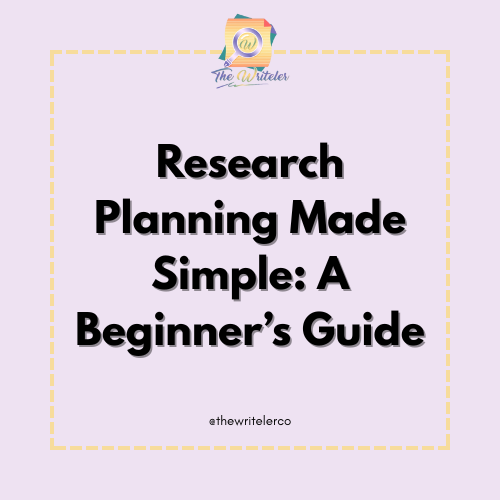Starting a research project can feel like standing at the edge of a vast forest — exciting, but also overwhelming. Where do you begin? How do you stay organized? And how do you make sure your work is meaningful and well-structured?
If you’re new to academic or professional research, planning is your most powerful tool. A solid research plan doesn’t just save time — it gives you clarity, focus, and confidence as you move through each stage of your project.
In this beginner-friendly guide, we’ll walk you through a simple, step-by-step approach to research planning , so you can start strong and finish even stronger.
Step 1: Define Your Research Topic
Before diving in, take time to clearly define what you want to study. A good research topic should be:
- Interesting to you (motivation matters!)
- Specific enough to explore deeply
- Relevant to your field or course
- Feasible given your time, resources, and access to data
Tip: Start with a broad idea and gradually narrow it down by asking:
- What problem or question am I curious about?
- Why does it matter?
- Who else has studied this?
Step 2: Formulate a Research Question
Your research question guides everything you do. It tells you:
- What kind of data you need
- Which methods to use
- How to interpret your findings
A strong research question is:
- Clear and focused
- Open-ended (not just yes/no)
- Realistic to answer within your scope
Example:
- ❌ Too broad: “What causes climate change?”
- ✅ Better: “How have local farming practices influenced soil degradation in rural India over the past decade?”
Step 3: Conduct a Preliminary Literature Review
Before collecting new data, understand what’s already known. A literature review helps you:
- Discover existing theories and findings
- Identify gaps your research can fill
- Refine your question and methodology
Start with general searches on Google Scholar, JSTOR, PubMed, or your university library database.
Tip: Organize your sources using reference managers like Zotero or Mendeley. Take notes on key themes, arguments, and unanswered questions.
Step 4: Choose Your Research Methodology
Now that you know what’s been done before, decide how you’ll gather and analyze your data. There are two main types of research methods:
🔹 Qualitative Research
- Explores experiences, meanings, and perspectives
- Methods: interviews, focus groups, observations, case studies
- Best for answering “how” and “why” questions
🔹 Quantitative Research
- Focuses on numerical data and statistical analysis
- Methods: surveys, experiments, content analysis
- Best for answering “what,” “how much,” and “how often” questions
You can also combine both in mixed methods research for a more comprehensive view.
Tip: Match your method to your research question. Ask yourself: What kind of evidence will best help me answer my question?
Step 5: Create a Research Timeline
Time management is crucial in any research project. Break your project into smaller tasks and assign realistic deadlines.
Here’s a sample timeline for a 10-week project:
| WEEK | TASK |
|---|---|
| 1–2 | Finalize topic, question, and literature review |
| 3 | Design research tools (e.g., surveys, interview guides) |
| 4–5 | Collect data |
| 6–7 | Analyze data |
| 8–9 | Draft your paper/report |
| 10 | Revise, proofread, submit |
Tip: Build in buffer time for unexpected delays — they happen to everyone!
Step 6: Plan for Ethical Considerations
Ethics are an essential part of responsible research. Always consider:
- Informed consent (especially when working with human subjects)
- Privacy and confidentiality
- Bias and fairness in data collection
- Proper citation and avoiding plagiarism
If you’re affiliated with a university, check if you need ethics approval from an institutional review board (IRB).
Tip: When in doubt, consult your advisor or mentor — ethics should never be an afterthought.
Step 7: Gather and Organize Resources
Make sure you have all the tools you need before starting:
- Access to databases, journals, and books
- Software for data collection and analysis (e.g., SPSS, NVivo, Excel)
- Note-taking apps or folders to store your materials
- Backup systems to protect your work
Tip: Use cloud storage (like Google Drive or Dropbox) and back up regularly to avoid losing progress.
Step 8: Stay Flexible and Keep Track
Research rarely goes exactly as planned. Be prepared to adapt your methods, refine your question, or even shift direction slightly based on what you learn.
Use tools like:
- Trello or Notion for task tracking
- Calendars or planners for scheduling
- Journaling or reflection logs to document decisions and insights
Tip: Regularly revisit your plan and adjust as needed. Flexibility is part of being a smart researcher.
Final Thoughts…
Research planning may seem like extra work at the beginning, but it’s the foundation that makes your entire project run smoothly. With a clear plan in place, you’ll feel more confident, stay on track, and produce better results.
Remember, every expert was once a beginner. Don’t worry if your first plan isn’t perfect — what matters is that you start, and keep improving along the way.

Ready to Begin?
Grab a notebook, open a digital planner, and start mapping out your research journey. Whether it’s a class assignment, thesis, or personal project, your plan is your roadmap to success.
Let The Writeler Co. support you in achieving academic and professional excellence! Whether you need assistance with research writing, proofreading, editing, or data analysis, our expert team is here to help.
📩 Email us today or 📲 message us on our Facebook account to get started. Let’s make your work shine!
Happy researching! 📚🔍📊





0 Comments